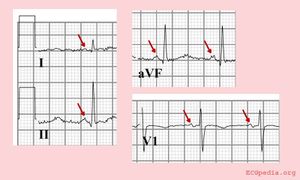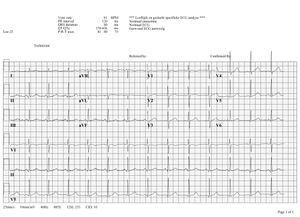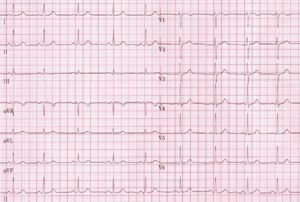Sinus Node Rhythms and Arrhythmias: Difference between revisions
(elttrdarl) |
(relelttrdome) |
||
| Line 1: | Line 1: | ||
chielt | |||
trdelpas | trdelpas | ||
{{nav| | {{nav| | ||
Revision as of 05:19, 26 December 2007
chielt trdelpas
| «Basics | Step 2: Heart Rate» |
| Author(s) | J.S.S.G. de Jong | |
| Moderator | I.A.C. van der Bilt | |
| Supervisor | ||
| some notes about authorship | ||
Normal heart rhythm
The normal heart rhythm is sinus rhythm. That means that the rhythm has its origin in the sinus node, the heart's fastest physiological impulse generator. The sinus node (SA) is located in the upper part of the wall of the right atrium. When the sinus node generates an electrical impulse, first the cells of the right atrium depolarise, then the cells of the left atrium, the AV (atrioventricular) node follows and at last the ventricles are stimulated via the His bundle.
With this knowledge it is quite simple to recognise normal sinus rhythm on the ECG.
- Criteria for normal sinus rhythm (see also Basics)
- A P wave (atrial contraction) precedes every QRS complex
- The rhythm is regular, but varies slightly while breathing
- The frequency ranges between 60 and 100 beats per minute
- The P waves maximum height is 2.5 mm in II and/or III
- The P wave is positive in I and II, and biphasic in V1
These last two definitions will be discussed in the topic P wave morphology. Heart rhythms which are not sinus rhythm are arrhythmias.
Sinus arrhythmias
Some variants of sinusrhythm exist:
- Asystole
- Sinustachycardia (>100 beats per minute)
- Sinusbradycardia (<50 beats per minute)
- Sinus arrest or pause
- Sino-atrial exit block
- Sick Sinus Syndrome
If the heart rate exceeds 100 bpm, the tachcyardia flow chart should be followed.
Examples




